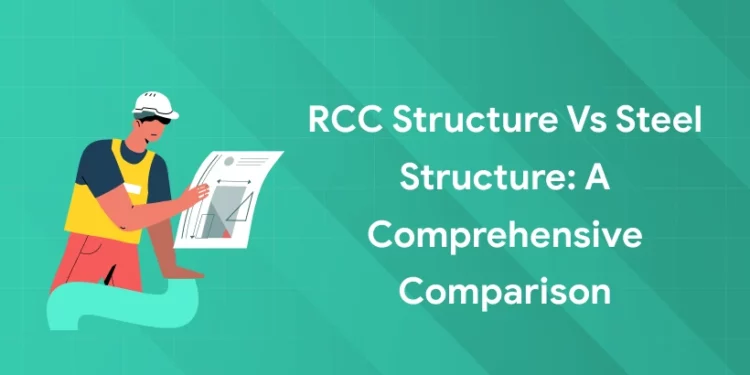Table of Contents
Steel and reinforced concrete cement (RCC) are two common building materials in the construction industry. Both materials are appropriate for various kinds of construction projects because of their distinct qualities. In this post, we will examine the properties of RCC and steel to help you grasp the differences between the two. Let us learn more about the topic “RCC Structure vs Steel Structure” and then decide which is the best building material for our project.
Register for the Structural Design Course by Entri Elevate! Learn from industry experts!
RCC Structure vs Steel Structure: Introduction
Steel and reinforced concrete are two popular building materials, each with special qualities and benefits. RCC is a composite material with exceptional durability and compressive strength that is composed of concrete and steel reinforcement. It is frequently utilized in beams, columns, and foundation construction. Conversely, steel is a material that can be used for a variety of purposes because of its great tensile strength and flexibility. This makes it perfect for constructions that need to support a lot of weight and span a lot of space. The decision between RCC and steel frequently comes down to the particular needs of the project, since each material has advantages and disadvantages of its own.
RCC Structure vs Steel Structure: A Comprehensive Comparison
1: What is the primary purpose of structural design?
Let us compare various aspects of the subject “RCC Structure vs Steel Structure” and find how different they are in each of them.
Material Composition and Strength
Reinforced cement concrete (RCC) is a composite material used in construction that is made up of structural concrete reinforced with steel or another reinforcing element. Steel is the most often utilized reinforcement because of its complementary qualities. This type of concrete is known as steel-reinforced cement concrete or simply reinforced cement concrete. Iron and carbon are the main constituents of steel. Sometimes traces of elements like manganese, silicon, nickel, chromium etc are added for different properties.
Strength is one of the main distinctions between steel and RCC. Steel is the perfect material for constructions that need to be able to support a lot of weight because of its great tensile strength. In contrast to steel, RCC has a lower tensile strength but an excellent compressive strength. Because of this, steel is the material of choice for buildings that must endure severe weather or large weights.
Speed and Ease of Construction and Cost Comparison
When deciding between RCC and steel for a building project, cost is still another crucial consideration. In terms of both material and construction costs, steel is often more costly than RCC. Nonetheless, steel constructions are frequently constructed more quickly, which might partially offset the higher expenses. In contrast, RCC is more economical when it comes to material costs, but it may take longer and need more work to build, which might affect the project’s total cost.
Durability and Maintenance
Both steel and RCC have benefits over one another in terms of durability. Steel is a long-lasting material for building projects because of its excellent durability and resistance to corrosion. However, although RCC is also long-lasting, it can need routine upkeep to avoid cracks and gradual degeneration. Both RCC and steel constructions may have their lifespans increased with proper care and maintenance.
Steel is a popular material for buildings that must adhere to stringent fire safety rules because of its excellent fire resistance. In the case of a fire, steel structures are less likely to collapse, giving residents a better level of protection. Though it might not provide as much protection as steel, RCC is likewise fire-resistant. Both steel and RCC constructions may have their fire resistance increased with the use of appropriate fireproofing techniques.
Design Flexibility
Because of its extreme flexibility, steel is easily moulded and formed to meet a variety of design specifications. Steel constructions may be used to create more elaborate and sophisticated designs because of their flexibility. However, RCC is less pliable and can need extra reinforcement and support to take on the appropriate form and design. Nonetheless, RCC is still a flexible material for building projects since it can be shaped into a variety of sizes and shapes.
Environmental Impact
Steel and RCC both have their environmental effects when it comes to sustainability. Steel manufacture is less ecologically friendly than RCC since it requires a lot of energy and can increase carbon emissions. RCC is a more environmentally friendly option for building projects since it is composed of natural resources like cement, sand, and aggregates. However, the environmental effect of both materials may be decreased by recycling and reusing them.
Get the best mentors to learn from! Click to watch the Structural Design Course by Entri demo class!
Transform Your Career with Our Structural Design Course!
Unlock Your Potential in Structural Design! Gain expert knowledge in designing robust structures and advance your career in the construction and engineering fields. Limited spots available! 🌟
Know MoreWhich One Should You Choose?
As we discussed above, the selection of materials should solely depend on the needs and demands of the individual project. Let us look at various scenarios in which it is better to use steel or better to use RCC.
Applications of Steel Structures
It is better to use steel as a building material in the following cases.
- High-rise structures: They should be built of steel because of the strength, lightweight, and speed of construction while using steel.
- Industrial/warehouse buildings: They should be built of steel due to their capacity to generate vast span areas at a low cost.
- Residential structures: They are constructed using a method known as light gauge steel.
- Temporary structures: They should be built of steel because then it would be easy to set up and dismantle.
Applications of RCC
It is better to use RCC in the following cases.
- Reinforced concrete is perfect for constructing floor and roof slabs, columns, and beams in residential and commercial buildings.
- The current tendency is to use reinforced concrete for bridges with short, medium, and large spans, which results in more visually pleasing and cost-effective constructions than steel bridges.
- Reinforced concrete is useful for water-retaining structures such as ground and elevated tanks, as well as hydraulic structures like gravity and arch dams. The material is commonly utilized in the building of big domes for water tanks, sports stadiums, and conference centres.
- Reinforced concrete is commonly used in earth-retaining constructions such as bridge abutments and retaining walls for earthen embankments.
- Reinforced concrete grid floors made up of beams and slabs are commonly utilized to cover vast spaces such as conference halls that require column-free space.
- RCC shells made of thin circular slabs and deep edge beams are a cost-effective alternative for aeroplane hangars.
- Reinforced concrete folding plate construction has been employed in industrial projects that require a big column-free space under the roof.
- In coastal locations where corrosion is a threat to maritime infrastructure such as wharves, quay walls, watchtowers, and lighthouses. For coastal warehouses, RCC trusses are preferable to steel trusses.
- RCC poles have nearly replaced steel poles for electricity transmission. Tall TV transmission towers are almost always made of RCC.
- RCC is favoured over steel for pressure vessel construction in atomic structures due to its superior radiation absorption properties as a result of its high strength and density.
- Precast and cast-in-situ reinforced concrete piles have been utilized for the foundations of many bridges and building types.
- RCC is also used to pave roads and airport runways.
RCC Structure vs Steel Structure: Conclusion
In conclusion, steel and RCC each have certain qualities that make them appropriate for different types of building projects. Steel is the perfect material for constructions that need to support a lot of weight because of its great strength, flexibility, and durability. However, RCC is a popular option for a variety of building projects due to its affordability, adaptability, and sustainability. The final decision between RCC and steel will be based on the project’s particular needs and the intended result. All this information is just the basics of structural design. Are you someone wishing to learn more about structural design? Are you someone who was rejected from an interview due to not knowing the basics of structural design? No worries! Entri got you covered!
The Structural Design Course by Entri Elevate is designed for civil engineers who want to progress their careers and get high-paying office positions in India and abroad. It provides students with the required skills and information to succeed in this dynamic sector. The curriculum provides thorough instruction and hands-on experience to prepare students for success in structural engineering.
|
Engineering Upskilling Courses
|
| MEP Course |
| BIM Course |
| Structural Design Course |
| Oil and Gas Course |
Transform Your Career with Our Structural Design Course!
Unlock Your Potential in Structural Design! Gain expert knowledge in designing robust structures and advance your career in the construction and engineering fields. Limited spots available! 🌟
Know MoreFrequently Asked Questions
Why is reinforced concrete superior to concrete?
Plain concrete has good strength in compression but is weak in bending. Its tensile strength is only around one-tenth that of its compressive strength. Bending a simple concrete part causes fractures and ruptures. For the same reason, plain concrete is not utilized in areas where bending might occur. Tensile strength is the capacity to withstand bending forces. Bending forces create tensile stresses in flexural elements such as beams and columns. Plain concrete’s total bending capability increases when it is reinforced by steel, which is more than a hundred times stronger than concrete under tension.
The steel bars compensate for the concrete’s lack of tensile resistance by essentially carrying all of the tension and functioning monolithically with the concrete. So, when concrete and steel bars work together to resist pressures, the outcome is high strength. Similar to how human bones support the flesh and bulk surrounding them.
Imagine a beam that is simply supported with an equally distributed load throughout the whole span. When the load is applied, the primary method of deflection is bending. As a result, the beam will be compressed at the top and tensioned at the bottom. Because concrete is weak in tension, reinforcing bars will be placed in the bottom section of the beams to prevent cracking in the stress zone.
Why is RCC gaining popularity among builders?
Concrete structures are appearing everywhere, in a variety of forms. Keep in mind that concrete is form-driven. You can make anything out of concrete. In addition to the distinct aesthetics attained by concrete construction, these structures provide some significant space advantages. Public and private developers should also recognize that employing cast-in-place reinforced concrete to frame a high-rise office building will result in more rentable areas due to lower floor-to-floor heights. RCC is a breakthrough material for constructing constructions ranging from simple to complicated. With major advancements in cement and steel quality, RCC will continue to discover new applications and become widely used in the twenty-first century.
What makes steel popular among builders?
Steel has the highest strength-to-weight ratio among all building materials. Furthermore, with new construction technologies, steel structures continue to be popular among business and multifamily developers. The use of girder slabs, staggered truss, and castellated beam construction allows for lower floor-to-floor heights than is customary in structural steel structures. Looking for large amounts of column-free space? Steel does not disappoint. Steel can support exceptionally long spans and have very open-bay footprints without the use of intermediary columns. It’s a material that can be used in a variety of ways to meet design needs.
What are the disadvantages of RCC as a building material?
- Because of its higher dead weight, RCC is less commonly utilized in high-rise structures, where the foundation would bear greater stress.
- When concrete reaches the end of its life, it can be crushed and recycled, but the recovered material cannot be utilized to make new concrete. As a result, concrete has practically little scrap value.
- Cement concrete can handle a lot of compression but not much strain, whereas steel can handle both.
- It is less desired in seismic zones because of its brittleness and lack of flexibility, which can cause immediate structural damage without notice.
What are the advantages of RCC as a building material?
- It can withstand extreme temperatures caused by fire for an extended period of time without losing structural integrity.
- Buildings made of cast-in-place reinforced concrete can withstand gusts of up to 200 mph and operate effectively even when hit by flying debris.
- Concrete does not require any additional fireproofing treatments to fulfil severe fire requirements and performs well in both natural and manufactured disasters.
- Concrete is a locally available material that normally takes little energy to transport to construction sites.
- In contrast to steel constructions, there is no need for significant upkeep. Additionally, not much money is spent on labour.
What are the disadvantages of steel as a building material?
- A clear and conclusive analysis technique and assumptions should be made before the construction of a structural system.
- Designing connections takes more time than connecting RC structures.
- Structural steel is more expensive than RC, particularly in India.
- Skilled labourers are needed.
- Steel may weaken and melt when exposed to extremely high temperatures. However, with the inclusion of passive fire safeguards, such as spray-on fireproofing, structural steel structures may withstand higher temperatures, providing added safety.
- They are susceptible to corrosion in humid or maritime settings. They therefore require continuous maintenance.
What are the advantages of steel as a building material?
- They can be built on-site quite quickly since a lot of the work may be prefabricated at the factory.
- The construction may be expanded with ease.
- Ease of repair, restoration, or retrofitting.
- The construction can be erected faster.
- They are flexible, which allows them to withstand dynamic (changing) stresses like wind and earthquakes. It can flex without cracking, which serves as a warning signal in earthquake zones.
- A variety of ready-made structural sections are available, including I, C, and angle sections.
- They may be constructed in any shape and clad with any type
- There are several connecting methods available, including bolting, welding, and riveting.
- Steel is a recyclable material.














